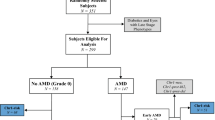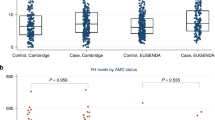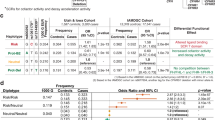Abstract
Age-related macular degeneration (AMD; OMIM #603075) is the most frequent cause of visual impairment in the elderly population, with severe disease affecting nearly 10% of individuals of European descent over the age of 75 years. It is a complex disease in which genetic and environmental factors contribute to susceptibility. Complement factor H (CFH) has recently been identified as a major AMD susceptibility gene, and the Y402H polymorphism has been proposed as the likely causative factor. We genotyped polymorphisms spanning the cluster of CFH and five CFH-related genes on chromosome 1q23 in 173 individuals with severe neovascular AMD and 170 elderly controls with no signs of AMD. Detailed analysis showed a common haplotype associated with decreased risk of AMD that was present on 20% of chromosomes of controls and 8% of chromosomes of individuals with AMD. We found that this haplotype carried a deletion of CFHR1 and CFHR3, and the proteins encoded by these genes were absent in serum of homozygotes. The protective effect of the deletion haplotype cannot be attributed to linkage disequilibrium with Y402H and was replicated in an independent sample.
NOTE: In the version of this article initially published, the G and A alleles of rs1831281 in Figure 1 should be reversed, and the block 2 haplotypes in Figure 1, Table 2 and Supplementary Table 2 should be corrected to 1:AGGCGACG, 2:AGGCGAAG, 3:GTGCGGAG, 4:GTATGAAA and 5:GTGTAAAG. The error has been corrected in the HTML and PDF versions of the article.
This is a preview of subscription content, access via your institution
Access options
Subscribe to this journal
Receive 12 print issues and online access
$209.00 per year
only $17.42 per issue
Buy this article
- Purchase on Springer Link
- Instant access to full article PDF
Prices may be subject to local taxes which are calculated during checkout


Similar content being viewed by others
Change history
14 March 2007
In the version of this article initially published, the G and A alleles of rs1831281 in Figure 1 should be reversed, and the block 2 haplotypes in Figure 1, Table 2 and Supplementary Table 2 should be corrected to 1:AGGCGACG, 2:AGGCGAAG, 3:GTGCGGAG, 4:GTATGAAA and 5:GTGTAAAG. The error has been corrected in the HTML and PDF versions of the article.
References
Mullins, R.F., Aptsiauri, N. & Hageman, G.S. Structure and composition of drusen associated with glomerulonephritis: implications for the role of complement activation in drusen biogenesis. Eye 15, 390–395 (2001).
Klein, R.J. et al. Complement factor H polymorphism in age-related macular degeneration. Science 308, 385–389 (2005).
Edwards, A.O. et al. Complement factor H polymorphism and age-related macular degeneration. Science 308, 421–424 (2005).
Haines, J.L. et al. Complement factor H variant increases the risk of age-related macular degeneration. Science 308, 419–421 (2005).
Hageman, G.S. et al. A common haplotype in the complement regulatory gene factor H (HF1/CFH) predisposes individuals to age-related macular degeneration. Proc. Natl. Acad. Sci. USA 102, 7227–7232 (2005).
Zareparsi, S. et al. Strong association of the Y402H variant in complement factor H at 1q32 with susceptibility to age-related macular degeneration. Am. J. Hum. Genet. 77, 149–153 (2005).
Schouten, J.P. et al. Relative quantification of 40 nucleic acid sequences by multiplex ligation-dependent probe amplification. Nucleic Acids Res. 30, e57 (2002).
Heinen, S. et al. De novo gene conversion in the RCA gene cluster (1q32) causes mutations in complement factor H associated with atypical hemolytic uremic syndrome. Hum. Mutat. 27, 292–293 (2006).
Reid, K.B. et al. Complement system proteins which interact with C3b or C4b; a superfamily of structurally related proteins. Immunol. Today 7, 230–234 (1986).
DiScipio, R.G. Ultrastructures and interactions of complement factors H and I. J. Immunol. 149, 2592–2599 (1992).
Jozsi, M. et al. FHR-4A: a new factor H-related protein is encoded by the human FHR-4 gene. Eur. J. Hum. Genet. 13, 321–329 (2005).
Jakobsdottir, J. et al. Susceptibility genes for age-related maculopathy on chromosome 10q26. Am. J. Hum. Genet. 77, 389–407 (2005).
Rivera, A. et al. Hypothetical LOC387715 is a second major susceptibility gene for age-related macular degeneration, contributing independently of complement factor H to disease risk. Hum. Mol. Genet. 14, 3227–3236 (2005).
van Leeuwen, R., Klaver, C.C., Vingerling, J.R., Hofman, A. & de Jong, P.T. The risk and natural course of age-related maculopathy: follow-up at 6 1/2 years in the Rotterdam study. Arch. Ophthalmol. 121, 519–526 (2003).
The International ARM Epidemiological Study Group. An international classification and grading system for age-related maculopathy and age-related macular degeneration. Surv. Ophthalmol. 39, 367–374 (1995).
Barrett, J.C., Fry, B., Maller, J. & Daly, M.J. Haploview: analysis and visualization of LD and haplotype maps. Bioinformatics 21, 263–265 (2005).
Acknowledgements
We thank D. McGibbon for assistance with DNA extraction; J. Silvestri, V. McConnell, G. Wright, G. Meenagh and C. Benson for blood samples from their patients; P. Zipfel for antisera for use in protein blotting; C. Cardwell for statistical help and Illumina for discussions on choice of SNPs for typing. This work was supported by The Health Foundation.
Author information
Authors and Affiliations
Contributions
A.E.H., N.O. and H.E. designed the SNP association study, A.E.H. and N.O. analyzed SNP data, T.G. and M.D.-T. performed protein blotting experiments, U.C. provided clinical information and patient samples and A.E.H. performed all other experiments and wrote the paper.
Note: Supplementary information is available on the Nature Genetics website.
Corresponding author
Ethics declarations
Competing interests
The Queen's University of Belfast has applied for a patent related to research reported in this paper.
Supplementary information
Supplementary Fig. 1
Haploview plot of haplotype block structure of CFH region. (PDF 165 kb)
Supplementary Fig. 2
Breakpoint region of 1,620 bases. (PDF 11 kb)
Supplementary Table 1
Logistic regression analysis of rs1061170 (Y402H) and the presence or absence of deletion of CFHR1 and CFHR3. (PDF 8 kb)
Supplementary Table 2
Association of CFH rs1061170 and of block 2 haplotypes in replication group. (PDF 6 kb)
Supplementary Table 3
Primer information. (PDF 10 kb)
Rights and permissions
About this article
Cite this article
Hughes, A., Orr, N., Esfandiary, H. et al. A common CFH haplotype, with deletion of CFHR1 and CFHR3, is associated with lower risk of age-related macular degeneration. Nat Genet 38, 1173–1177 (2006). https://doi.org/10.1038/ng1890
Received:
Accepted:
Published:
Issue Date:
DOI: https://doi.org/10.1038/ng1890
This article is cited by
-
Levels of complement factor H-related 4 protein do not influence susceptibility to age-related macular degeneration or its course of progression
Nature Communications (2024)
-
Mutations in the alternative complement pathway in multiple myeloma patients with carfilzomib-induced thrombotic microangiopathy
Blood Cancer Journal (2023)
-
C1q and the classical complement cascade in geographic atrophy secondary to age-related macular degeneration
International Journal of Retina and Vitreous (2022)
-
Factor H-related protein 1 (FHR-1) is associated with atherosclerotic cardiovascular disease
Scientific Reports (2021)
-
The effects of common structural variants on 3D chromatin structure
BMC Genomics (2020)



